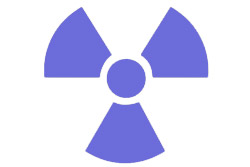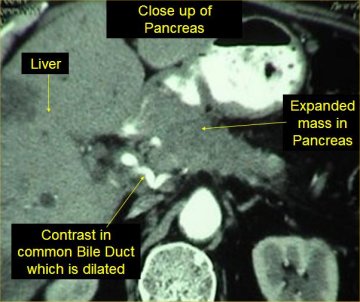- What is Pancreatic Cancer (Adenocarcinoma of the Pancreas)
- Statistics on Pancreatic Cancer (Adenocarcinoma of the Pancreas)
- Risk Factors for Pancreatic Cancer (Adenocarcinoma of the Pancreas)
- Progression of Pancreatic Cancer (Adenocarcinoma of the Pancreas)
- Symptoms of Pancreatic Cancer (Adenocarcinoma of the Pancreas)
- Clinical Examination of Pancreatic Cancer (Adenocarcinoma of the Pancreas)
- How is Pancreatic Cancer (Adenocarcinoma of the Pancreas) Diagnosed?
- Prognosis of Pancreatic Cancer (Adenocarcinoma of the Pancreas)
- How is Pancreatic Cancer (Adenocarcinoma of the Pancreas) Treated?
- Pancreatic Cancer (Adenocarcinoma of the Pancreas) Prevention
- Pancreatic Cancer (Adenocarcinoma of the Pancreas) References
What is Pancreatic Cancer (Adenocarcinoma of the Pancreas)

Roughly 1% of the gland produces the hormones insulin and glucagon, which regulate the production, storage and uptake of glucose by the body’s tissues. The other 99% of the gland produces pancreatic fluid, which is excreted into the duodenum to aid in the process of digestion. This fluid is made up of digestive enzymes and other substances secreted by a network of small ducts in the pancreas (called acinus) which join larger ducts secreting sodium bicarbonate. This mixture combines to form the digestive fluid of the pancreas, which flows through a central pancreatic duct until it joins the common bile duct from the gallbladder and liver and enters the duodenum.
For descriptive purposes, the pancreas is divided into various parts: the head, the body and the tail. Tumours can grow in any of these areas or diffusely throughout the entire organ. The most common site of pancreatic cancer is in the pancreatic head, which is situated next to the duodenum.
 |
For more information on the anatomy of the digestive system, see Gastrointestinal System. |
Commonly, the term pancreatic cancer refers to pancreatic adenocarcinoma, which is a cancer of the cells that make up the ducts in the pancreas. Pancreatic adenocarcinoma occurs when these cells grow in an uncontrolled, irregular and prolific manner. As they grow, these mutated cells begin to disrupt the function of the pancreas and also press upon surrounding organs. Like other cancers, pancreatic cancer can spread either by invading areas of the body next to where it started growing (known as the ‘primary’ site), or by spreading through the bloodstream or lymphatic system to other areas distant from the primary tumour. These distant areas of cancer are known as ‘secondaries’ or ‘metastases’ and in pancreatic cancer are often in areas such as the liver, lungs and bones. Because the early symptoms of pancreatic cancer are not overt and there are no effective screening tools to detect the disease at an early stage, often by the time the disease is diagnosed the cancer has already spread (metastasised) and as a result prognosis is extremely poor.
Statistics on Pancreatic Cancer (Adenocarcinoma of the Pancreas)
Cancer is Australia’s leading cause of burden of disease. Although not one of the most common types of cancer in Australia, accounting for only 2.3% of all cancers in 2007, pancreatic cancer is associated with an extremely high mortality rate. It has the fifth highest rate of mortality and accounts for 5.6% of all deaths from cancer. Of those people with pancreatic cancer, 89% will die from the disease.
Men are 1.4 times more times likely to develop pancreatic cancer than women, and a person’s risk of developing pancreatic cancer increases with age. The risk of developing pancreatic adenocarcinoma by age 70 is approximately 0.5% or 1 in 200 people.
Risk Factors for Pancreatic Cancer (Adenocarcinoma of the Pancreas)

Smoking has been identified as the strongest environmental risk factor and has been shown to double the risk of developing pancreatic cancer. Although the net effect of this risk is not great on an individual basis, considering the amount of people who smoke, it is very important at an overall population level.
A diet rich in animal fats as well as the chronic use of alcohol have also been shown to increase the risk of developing pancreatic cancer.
Chronic pancreatitis and diabetes, although not proven to be direct causes, have also been associated with an increased incidence of pancreatic cancer. Finally, a family history of pancreatic cancer greatly increases someone’s risk (18-fold if a first-degree relative has been diagnosed). Other inherited diseases, such as familial breast and ovarian cancer, hereditary pancreatitis and familial atypical multiple-mole melanoma syndrome, are also associated with an increased risk of developing pancreatic cancer.
Progression of Pancreatic Cancer (Adenocarcinoma of the Pancreas)
Pancreatic cancers are slow-growing tumours which are often not diagnosed until advanced stages when the cancer has spread to other areas of the body (metastasised). Tumours of the pancreatic head may sometimes be discovered before metastasis due to clinical signs of jaundice, whereas tumours of the body and tail are more likely to be discovered in advanced stages of the disease.
Pancreatic cancer spreads by direct invasion of surrounding structures such as the muscle and bone of the abdominal wall or into the small intestine (duodenum). Local spreading can also be caused by cancer cells floating around the abdominal cavity. Spread to lymph nodes can occur as well as distant secondary spread to liver, lung and bones via the bloodstream.
Symptoms of Pancreatic Cancer (Adenocarcinoma of the Pancreas)
Early in the disease process, the symptoms are few, which is why pancreatic cancer is often only diagnosed in advanced stages of the disease. Often the first signs of pancreatic cancer are long-standing pain that radiates from the upper abdomen through to the back, weight loss, decreased appetite, jaundice (a yellow tinge to the skin and the whites of the eyes), dark urine and pale clay-coloured stools. Individuals may also experience nausea, vomiting and general malaise (feeling fatigued or unwell).
Clinical Examination of Pancreatic Cancer (Adenocarcinoma of the Pancreas)
Early in the disease, there are few clinical signs. As the disease progresses, signs of pancreatitis may include jaundice, weight loss, and upper abdominal pain radiating to the back. In addition, there may be a palpable mass in the upper part of the abdomen. In late stages, lymph nodes situated above the collar bone may be felt, as well as a distended abdomen with prominent veins.
How is Pancreatic Cancer (Adenocarcinoma of the Pancreas) Diagnosed?
Examination

Blood tests
In addition to the examination, blood tests will be sent to the laboratory to look for evidence that either supports the diagnosis or suggests another cause for the symptoms.
These may include tests that look at the level of pancreatic enzymes in the blood, the function of the liver, the presence of viral hepatitis, and measures of the levels of various blood cells as well as other biological markers of inflammation in the body.
Tumour markers
Many cancers have specific tumour markers, or substances in the blood, which are raised in the presence of the disease. However, there are often a number of different processes in the body (not just cancer) that can raise these markers, and as a result they are not a reliable means of confirming diagnosis. The major use of these markers is in monitoring the progression of the cancer or the response to treatment. The tumour markers used in pancreatic cancer are called CA19-9 and CEA.
Imaging and investigations
Diagnosis of pancreatic cancer is usually made by abdominal CT, which can visualise abnormal masses in the pancreas. Once a mass has been detected using CT scan, a sample of the cancer cells (called a biopsy) can be taken using a very fine needle guided by ultrasound or CT imaging. This sample can help to determine whether any cancer cells present are from a pancreatic adenocarcinoma, from other rarer pancreatic cancers, or actually metastatic cancer cells from a primary cancer somewhere else in the body.
Staging
An important step in treating cancer is to assess how advanced the disease is. In other words, how large the primary site of the cancer is and how far it has spread throughout the body. In general terms, this is determined by assessing if the tumour has stayed within the pancreas, spread to surrounding structures or spread via the bloodstream to distant sites (i.e. metastasised). In addition, it takes into account whether the cancer has spread via the lymphatic system to the lymph nodes. Collectively, this is known as the TNM staging system. The stage of the cancer determines the different treatment options and the prognosis. If the cancer has stayed within the pancreas or spread to certain nearby organs such as the duodenum, stomach, bile duct or spleen, then surgical removal may be possible. If the cancer has spread to more problematic nearby structures such as blood vessels or to sites such as the liver, lungs or bone, surgical removal is not possible.
Other investigations that may help in staging the cancer include chest x-rays, magnetic resonance imaging (MRI), ultrasound scan and, in selected cases, diagnostic laparoscopy (a surgical procedure that allows the doctor to examine within the abdomen and pelvis).
Prognosis of Pancreatic Cancer (Adenocarcinoma of the Pancreas)
With pancreatic cancer, long-term survival is poor. Surgical removal of the tumour discovered in the early stages of the disease gives the best chance of cure. Even in this case, only 10–20% of individuals survive for 5 years or longer, and approximately 50% will have a recurrence of the cancer. For those diagnosed in the later stages of the disease, the average survival is 6 months, with 20% surviving to 1 year and only 4% surviving 5 years.
How is Pancreatic Cancer (Adenocarcinoma of the Pancreas) Treated?

Options for treatment include surgical removal (called resection), chemotherapy (treatment with drugs that kill the cancer cells) and radiotherapy (using radiation to kill cancer cells), as well as treatment for pain and other symptoms and complications of the disease. The stage of the cancer determines the different treatment options and the prognosis. If the cancer has stayed within the pancreas or spread to certain nearby organs such as the duodenum or bile duct, then surgical removal may be possible. If the cancer has spread to more problematic nearby structures such as blood vessels or metastasised to sites such as the liver, lungs or bone, surgical removal is not possible.
Surgery
Complete surgical removal of the tumour is the only definitive treatment for pancreatic cancer. However, this option is only available in approximately 10–15% of tumours that have not invaded important nearby structures such as major blood vessels and have not spread to distant organs such as the liver, bone or lungs. Depending on the location of the cancer, the surgeon may remove a part of the pancreas plus parts of other nearby organs such as the spleen, duodenum, stomach and bile duct. In rare cases, the entire pancreas is removed.
Chemotherapy
Chemotherapy can either be used before surgery (called neoadjuvant chemotherapy) to shrink the tumour in order to give the surgeons a better chance of removing all the cancerous cells, or after surgery (called adjuvant chemotherapy) with the aim of destroying any remaining cancer cells that may have escaped into the bloodstream or lymphatic system and preventing them travelling to other areas of the body and causing new areas of cancer to grow. Chemotherapy is also used to treat cancer that cannot be removed surgically. Evidence has shown that chemotherapy results in a significant increased survival for individuals with advanced pancreatic cancer when compared to best supportive care (i.e. treatment to relieve the symptoms and pain from cancer without trying to kill or reduce the amount of cancer in the body).
There are many different chemotherapy drug treatments that can be used. The initial first-line treatment (the treatment generally used first) that has shown to be most effective to date is a drug called gemcitabine (sold as Gemzar) used alone or in combination with another chemotherapy drug. Evidence shows that this treatment increases the chance of the cancer responding to chemotherapy, as well as increasing the length of time before any recurrence of the cancer and the length of time individuals survive. However, this treatment does have increased toxicity and there is a higher likelihood of experiencing side effects such as poor immunity, nausea and vomiting.
If the cancer does not respond to the first-line treatment, other chemotherapy regimens may be used, but there is currently no clear consensus on what the best drug or combination of drugs is. In addition, most people are very physically unwell in these instances and as a result are not suitable to receive further chemotherapy. Second-line (therapy used after first-line treatment) chemotherapy treatments include combinations of different chemotherapy drugs such as ‘FOLFOX’, which consists of a 5-fluorouracil drug (e.g. Efudix) plus an oxaliplatin drug (e.g. Eloxatin), and ‘FOLFIRI’ (5-fluorouracil plus folinic acid).
Radiotherapy

- External beam radiotherapy (EBRT): Radiation is fired at the pancreatic cancer from outside the body. This often has a high toxicity and can cause collateral damage to surrounding structures in the body;
- Intensity-modulated radiotherapy (IMRT): An advanced type of radiation that uses a computer program to send high-dose radiation to the cancer, while blocking the radiation that reaches the nearby structures; and
- Intra-operative radiotherapy (IORT): Radiation is focused on the pancreatic cancer internally, during surgery.
The advantage of IMRT and IORT is that they allow an increased radiation dose to the tumour while minimising the toxic side effects to the rest of the body.
Evidence shows that radiation treatment is more effective when used in conjunction with chemotherapy, as it is thought that chemotherapy drugs make the cancer more sensitive to the radiation.
Symptomatic / palliative treatments
Biliary and GI tract obstruction
As the cancer grows and progresses, many individuals experience other symptoms from the cancer pressing on surrounding organs. Most commonly, it can cause a blockage of the bile duct that runs from the gallbladder to the duodenum (the first part of the small intestine). This happens in 65–75% of individuals and results in jaundice (a yellowing of the skin and the whites of the eyes). Likewise, the cancer can cause a blockage of the duodenum or in the outlet from the stomach into the small intestine, which happens in 10–25% of people. In all these cases, the most effective treatment is to have a stent (a small tube made of sterile plastic or metal) inserted into the blocked area to keep it open.
Pancreatic enzyme deficiency
It is very common for individuals with pancreatic cancer to be deficient in the pancreatic digestive fluid that helps absorb and digest fats, proteins and carbohydrates. This leads to oily faeces, cramping, weight loss and poor nutrition. Treatment consists of taking tablets daily to replace the digestive enzymes that are normally in the pancreatic fluid. It is also a good idea to consult a dietitian, who may be able to help with dietary changes to reduce symptoms.
Thromboembolic disease
Individuals with pancreatic cancer have an increased risk of developing thromboembolic disease (problems with increased clotting of the blood). This can result in blot clots in the veins in the legs, called deep vein thrombosis (DVT) or, in some cases, blood clots that travel to the lungs (called a pulmonary embolism). For individuals who develop clots, blood-thinning medications are recommended.
Pain control
Individuals in severe pain should have strong pain relief. In this case, morphine is the recommended treatment. Oral tablets are preferred, but if you have difficulty taking oral medications then intravenous (medication injected into the vein) morphine can be used. You can also seek advice from specialist pain and palliative care doctors, as well as a psychologist or counsellor as depression can often result from the chronic nature of the pain.
Follow up
Individuals who have had surgical removal of their cancer should see the doctor for a follow-up appointment every 3–6 months for the first 2 years, and then yearly beyond this time. Individuals undergoing chemotherapy or radiotherapy are usually assessed after each cycle of chemotherapy for signs of toxic side effects and evaluated to see how the cancer is responding to treatment every 2 months.
As well as asking questions as to how you are feeling, the doctor will perform an examination and take blood tests to look for tumour markers in the blood that may show how well the cancer is responding to treatment. The tumour markers used in pancreatic cancer are called CA19-9 and CEA. In addition, a CT scan may be used to monitor response to treatment or to see if there has been any new disease growth.
Pancreatic Cancer (Adenocarcinoma of the Pancreas) Prevention
The main ways a person can reduce their risk of developing pancreatic cancer is to address a number of lifestyle factors. Quitting or reducing smoking, and reducing calorie, fat and alcohol intake to low or at least moderate levels are very important preventative measures that can be undertaken. In many cases, your doctor can help develop management plans to assist in this process. Modifying the lifestyle risk factors of diet, alcohol and smoking are even more important in light of the fact that there are no effective screening tools available to detect the early stages of pancreatic cancer. As a result, the disease is commonly diagnosed at an advanced stage with corresponding poor prognosis.
Pancreatic Cancer (Adenocarcinoma of the Pancreas) References
- Moore KL, Dalley AF, Agur AM (eds). Clinically Oriented Anatomy (6th edition). Philadelphia, PA: Lippincott Williams & Wilkins; 2009. [Book]
- Saladin KS. Anatomy and Physiology: The unity of form and function (5th edition). New York: McGraw-Hill; 2010. [Book]
- Cotran RS, Kumar V, Collins T, Robbins SL. Robbins Pathologic Basis of Disease (8th edition). Philadelphia, PA: WB Saunders Company; 2010. [Book]
- Cascinu S, Falconi M, Valentini V, Jelic S. Pancreatic cancer: ESMO Clinical Practice Guidelines for diagnosis, treatment and follow-up. Ann Oncol. 2010;21(Suppl 5):v55-8. [Abstract | Full text]
- Australian Cancer Incidence and Mortality (ACIM) books [online]. Canberra, ACT: Australian Institute of Health and Welfare (AIHW); 16 December 2010 [cited 17 April 2011]. Available from: URL link
- Howlader N, Noone AM, Krapcho M, et al (eds). SEER Cancer Statistics Review 1975-2008 [online]. Bethesda, MD: National Cancer Institute; 15 April 2011 [cited 17 April 2011]. Available from: URL link
- Thiébaut AC, Jiao L, Silverman DT, et al. Dietary fatty acids and pancreatic cancer in the NIH-AARP diet and health study. J Natl Cancer Inst. 2009;101(14):1001-11. [Abstract | Full text]
- Gapstur SM, Jacobs EJ, Deka A, et al. Association of alcohol intake with pancreatic cancer mortality in never smokers. Arch Intern Med. 2011;171(5):444-51. [Abstract]
- Marx JA, Hockberger RS, Walls RM, et al. Rosen’s Emergency Medicine: Concepts and clinical practice (7th edition). Philadelphia, PA: Mosby/Elsevier; 2010. [Book]
- Braunwald E, Fauci AS, Kasper DL, et al. Harrison’s Principles of Internal Medicine (17th edition). New York, NY: McGraw-Hill Publishing; 2008. [Book]
- Longmore M, Wilkinson I, Turmezei T, Cheung CK. Oxford Handbook of Clinical Medicine (7th edition). Oxford: Oxford University Press; 2008. [Book]
- Clinical practice guidelines in oncology: Pancreatic adenocarcinoma [online]. Fort Washington, PA: National Comprehensive Cancer Network; 2011 [cited 17 April 2011]. Available from: URL link
- Griffin JF, Smalley SR, Jewell W, et al. Patterns of failure after curative resection of pancreatic carcinoma. Cancer. 1990;66(1):56-61. [Abstract | Full text]
- Sultana A, Tudur Smith C, Cunningham D, et al. Meta-analyses of chemotherapy for locally advanced and metastatic pancreatic cancer: Results of secondary end points analyses. Br J Cancer. 2008;99(1):6-13. [Abstract | Full text]
- Makrilia N, Syrigos KN, Saif MW. Treatment for refractory pancreatic cancer. Highlights from the “2011 ASCO Gastrointestinal Cancers Symposium”. San Francisco, CA, USA. January 20-22, 2011. J Pancreas. 2011;12(2):110-3. [Abstract | Full text]
- Ogawa K, Karasawa K, Ito Y, et al. Intraoperative radiotherapy for resected pancreatic cancer: A multi-institutional retrospective analysis of 210 patients. Int J Radiat Oncol Biol Phys. 2010;77(3):734-42. [Abstract]
All content and media on the HealthEngine Blog is created and published online for informational purposes only. It is not intended to be a substitute for professional medical advice and should not be relied on as health or personal advice. Always seek the guidance of your doctor or other qualified health professional with any questions you may have regarding your health or a medical condition. Never disregard the advice of a medical professional, or delay in seeking it because of something you have read on this Website. If you think you may have a medical emergency, call your doctor, go to the nearest hospital emergency department, or call the emergency services immediately.








